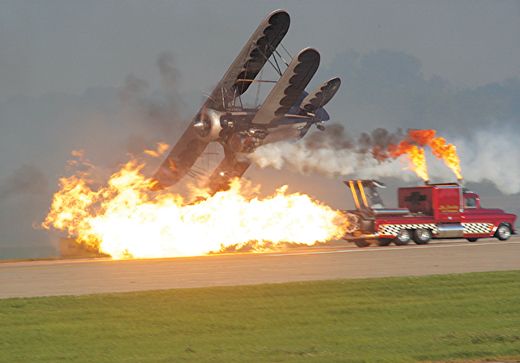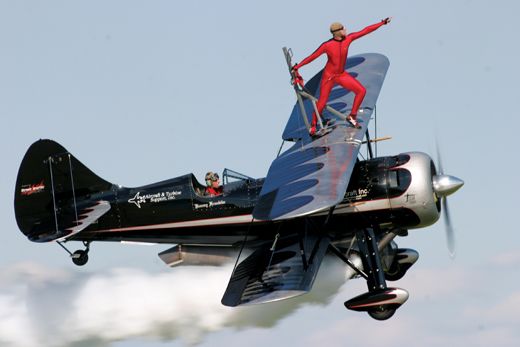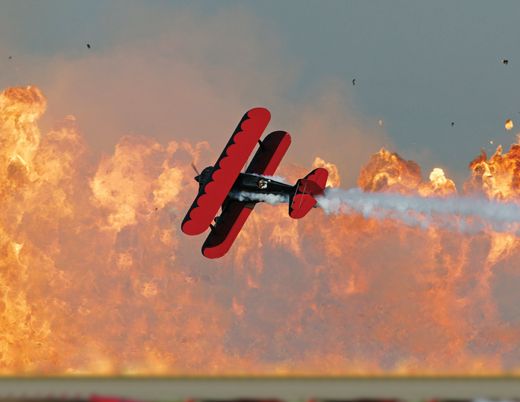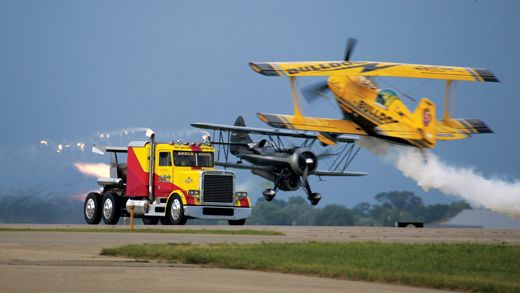Extreme Airshow
A fellow performer remembers the act that pushed too far.
/https://tf-cmsv2-smithsonianmag-media.s3.amazonaws.com/filer/mod_631-jan07.jpg)
In 37 years of flying aerobatics, I have come to think of airshows as a great place to hang out with my friends. Much of the flying has been a backdrop for parties and picnics, but every once in a while, I have been grabbed and held in a time-stopping moment as I watched someone fly. When it has happened, I recall the color of the air, the shirt on the back of the man in front of me, the gasps and sighs of the audience, and the airplane filling the sky: A Vulcan bomber with its wing nearly scraping the ground in a turn. Bob Hoover’s Aero Commander looping and rolling with both engines off. Jim Holland’s green and white Citabria doing a low-level outside loop. A Red Baron Stearman flying a simple early morning show in air so thick and still that the plane’s smoke trailed behind it like white crepe paper in a blue room.
But the greatest time-stopper was the Masters of Disaster, an act with three pilots—Jimmy Franklin, Bobby Younkin, and Jim LeRoy—who tore up the sky, chased each other, raced jet trucks, dodged fire and smoke, and changed what we expected from airshows forever. It was an act that scared us silly, made us wish they would never stop, then broke our hearts when two of them, Franklin and Younkin, were killed flying at an airshow in Moose Jaw, Saskatchewan, on July 10, 2005.
The last time I saw them was the year before, at the Experimental Aircraft Association fly-in at Oshkosh, Wisconsin. Before they flew, Kyle Franklin, Jimmy’s son, warned the audience: “This is dangerous. This is a high-risk act.” Then, instead of announcing the act and reciting the usual statistics and how-great-I-am bios, he turned on the soundtrack and narrative tape.
It began with epic science fiction movie music, and a robotic voice that said: “Ladies and gentlemen, children of all ages, allow me to take you back—far, far back to the gloomy dark ages of the early 15th century, a time when jet-powered vehicles roamed the face of the earth, unregulated, unmerciful, and undeterred, opposed only by the Fully Automated Annihilators, known to all as the FAA.” Here hyenas laughed like maniacs.
Before any airplane took off, a wall of people, a mile long, was up against the crowd line; they were all holding their breath. I was in the performers’ pit, and every pilot was standing as close as he or she could get to the flightline. At one end of the runway, LeRoy was in the black and yellow Pitts with a modified 400-horsepower Lycoming engine (his “Bulldog Pitts,” he called it), and at the opposite end, Younkin was in Samson, a 450-hp black and red replica, built by Steve and Liz Wolf, of a 1940s racing biplane. At crowd center, on a parallel taxiway, Franklin’s massive black Waco grumbled and hissed smoke, its uncowled General Electric J85 jet engine clamped to its belly like a demon hitching a ride.
While the pilots worked the crowd, revving their engines and blasting smoke behind their planes, the music and narration weaved a tongue-in-cheek spell, recalling an over-the-top B-movie: King Kong Meets Godzilla With Howling Biplanes, Jet Trucks, and a Wall of Flame. This was going to be an in-your-face show, one that defied convention and mocked what the pilots would call “the misplaced desire to dumb down a genuinely dangerous profession.”
The soundtrack shifted from science fiction to a horror movie funeral march. Then a wolf howled, dogs barked, and an air raid siren wailed above the airfield. From opposite ends of the runway, two biplanes raced toward each other. LeRoy yanked his Pitts off the runway and straight into a vertical climb, stopped it mid-air, then hovered just above the runway. Younkin, meanwhile, aimed for the Pitts, snap-rolling Samson just above it.
Younkin, who always made crowds gasp with his low-level snap-rolls on takeoff, had taught himself aerobatics when he was 16. He was in the back seat of his father’s new Decathlon while Jim, his father, practiced slow rolls. Like all beginners, Jim was having a hard time with them. Every time the plane rolled to the left, its nose dropped sharply and veered to the right at the end. When Bobby pointed that out, Jim said: “Well you try it!” Bobby did, and just from analyzing his father’s attempts he did it exactly right. Today, Jim recalls thinking, Maybe aerobatics is like music; those who are going to excel have this special gift. “Gifted people are very intense and they are the ones who want to practice all the time,” he says. “Bobby had to be flying all the time.”
Younkin flew his first airshow when he was 18, but made his living hauling freight in a Twin Beech and a Learjet. Later, he performed at airshows in both aircraft. Neither had been designed for aerobatic flying, but he flew them within their allowable G-load limits, with precision and grace.
The Masters of Disaster fed another side of Younkin’s personality. “On one hand, Bobby was this kind, gentle, polite Southern gentleman,” LeRoy says, “but when he strapped into Samson the horns came out—the devil horns!” The act brought out the horns in all of them.
Above the Oshkosh runway, after dazzling solo maneuvers, Younkin and LeRoy chased each other to 500 feet, where they drew a smoky circle. Franklin lit the fire in his big black 2,000-horsepower Waco. With a 50-foot, 1.5-second ground roll, the plane leaped into the air and rocketed through the circle like a bullet through a bull’s eye. As the team’s pyro experts set off the first charge of dynamite on the far side of the runway, guitars and drums exploded into a heavy metal frenzy.
When I first flew at shows Franklin performed in, back in the early 1970s, he was notorious for consistent but daring low-level flying. Someone asked him, “Why do you fly so low? Half the people can’t see you.” He answered, “Yeah, but they’re trying.”
Most pilots have to work their way down to extremely low altitudes, but Franklin grew up in a flying family in New Mexico, where he and his brother Steve would fly between the family’s two ranches. “We never got above power-line height,” Steve says, “and sometimes we would go under them.” They routinely rolled their Super Cub tires along the ground for entertainment, and once, when they were out without a shotgun, they tried to bop a coyote on the head with the tail wheel.
The low-level flying could backfire. Once, in the 1980s, Franklin made a low turn during a solo routine in an Aerostar and sliced off a bit of wingtip on a fence he had not seen (he landed without a problem, and parked his aircraft so the wingtip wasn’t visible). But anyone who saw his inverted pickup of a ribbon suspended between two Coke bottles would probably agree that the low flying paid off.
Franklin’s plane was as wild as his imagination. He got the idea of adding a jet engine to the Waco when he saw Star Wars, but he couldn’t find a builder willing to figure out how to do it. Then, in the 1990s, he met Les Shockley, who made a business out of putting jet engines on trucks. Shockley figured out how to put one safely on the modified Waco. At Oshkosh, after Franklin torque-rolled above the airfield, he yanked the jet around to join the other airplanes, already fighting like yard dogs with their teeth bared. On the ground, the pyrotechnics team, headed by Rich and Dee Gibson, watched for opportunities. Any time the airplanes flew low over the pyro field, the team exploded dynamite in cardboard boxes filled with plastic bags of gasoline. “Everyone expects the fire, smoke, and noise,” Rich Gibson says, “but they’re all surprised by the heat.” At the end of the show, when they lit a thousand-foot wall of fire, we could feel it on the other side of the runway.
Gibson was an explosives expert in Vietnam, where he disarmed booby traps for the Army. In 1981 he helped the (then-named) Confederate Air Force simulate bombs and strafing runs at an airshow in Rockford, Illinois, and warbird pilots have been demanding the talents of Rich’s Incredible Pyro ever since. “MOD was the first time that we used pyro strictly to add to the entertainment value,” he says. It may not have made technical sense in the dogfight, but the Masters of Disasters was not about logic.
“I’ve never been a fan of the typical airshow dogfight,” LeRoy says. “The pilots might be having fun as they try to get each other in their gunsights, but it can lack entertainment value. With the MOD dogfight, we took the most crowd-pleasing aspects—near-misses and close chases—and did them over and over, while never getting too far from show center.”
Like the other two pilots, LeRoy grew up in a flying family: His father, uncle, and grandfather were airline pilots. He took his first aerobatic lesson at Art Scholl Aviation in 1984 while serving in the Marine Corps at Camp Pendleton in California. By 1992 LeRoy had saved enough money to buy his first aircraft, a 1979 Super Decathlon. He performed in his first airshow in 1995.
LeRoy and Franklin first flew together in 2001 at the Elkhart, Indiana airshow; the organizers put them in the air at the same time for a competitive flyoff. They liked each other’s style, so three months later they began practicing aggressive dogfighting. In 2002 they flew shows together as an act, adding pyro and the two-airplane jet truck attack. The following year, Younkin, who had flown many airshow dogfights with Franklin, joined up (officially, the members of the act were the X Team, and the act itself was the Masters of Disaster).
MOD did not emphasize aerobatic maneuvers, says LeRoy, but rather near-misses and lots of things happening simultaneously, like explosions and flying though the flames produced by the jet truck. MOD was fluid. LeRoy compares it to the Jimi Hendrix song “Little Wing”: “There was a beginning, middle, and end, with lyrics that were sung basically the same every time,” he says, “but in between this structure were wonderful variations, and every live performance was different.”
To transition from the dogfight to the jet truck attack, the pilots did a maneuver with turns, splits, and close crosses that they called the Dairy Turn. At the end of it, the three would be coming at the truck from different directions.
While they did that, Kent Shockley, Les’ son, fired up Shockwave. Built on a 359 Peterbilt shell, the truck has three Pratt & Whitney J34-48 afterburning engines that produce a total of 36,000 pounds of thrust. After a 300-mph dash down the runway, the truck relies on six wheel disc brakes and two 16-foot parachutes to stop. “Nothing on it has been chopped down,” Shockley says. “It is as aerodynamic as
a barn.”
As it drove down the taxiway, the truck spewed a dragon’s breath of flames and clouds of smoke thick enough to hide a battleship. On the soundtrack Kid Rock sang, “I am the bullgod, I am free…,” followed by a 1950s oldie, “Beep, beep, beep, beep, his horn went beep, beep, beep…,” and back to Kid Rock: “I’m tripping, tripping…,” then a double clutch into “Whoa black betty, bam-a-lam….”
The planes popped in and out of the smoke, diving on the truck until it reached the end of the taxiway, where it turned onto the runway for the grand finale: the airplane race, with the thousand-foot wall of fire as a backdrop. Shockley describes the view from inside the truck: “They tried to time it so they were slicing by the truck at the same time. When they were getting close, I torched them. If they were coming in on the right side, they would bank left and slice right through the flame.
“You’ve seen a lot of these acts where guys fly by each other, looking like they are going to hit each other, but they leave a small margin for error. But those guys flew as close as it looked.
“Probably the most exciting thing was the head-to-head. Franklin would be coming up from behind, Bobby would be overhead, and LeRoy would come out of a hover 5,000 feet from the vehicle when he flattened out on the runway. That was my cue to launch. I would travel 2,000 feet, which is how long it takes for the truck to reach 300 mph. LeRoy would be off the edge of the runway, coming at me trimming the grass with his wheel pants. We crossed at a 500-mph closure rate.”
As a spectator, I thought the scariest part of the show was when the planes disappeared in the smoke. But in the end, when Franklin and Younkin collided, it was in clear air.
It was Sunday, July 10, 2005, at the Saskatchewan Airshow in Moose Jaw, home of the Canadian Armed Forces jet demonstration team, the Snowbirds. MOD was the last act to fly before the Snowbirds. “The first part of our demonstration had gone flawlessly,” LeRoy recalls. “We were nailing our crosses and flying a fairly tight show.
“And then they were gone. It happened just that fast.”
According to the findings of the Transportation Safety Board of Canada’s accident investigation board:
“The Dairy Turn manoeuvre had been modified such that a temporary loss of visual contact could occur immediately before the aircraft crossed flight paths. This modification made timing critical and added two potential points of collision….
“The climb initiated and maintained by the Wolf-Samson pilot was not part of the planned manoeuvre. The climb was consistent with the pilot concluding that the Waco was late, and because he did not have visual contact with the Waco, that there was an imminent risk of collision. His climb would have permitted the Waco to pass ahead and below.
“The climb of the Waco pilot was consistent with the pilot concluding that the lateness of the turn toward the Wolf-Samson had created an imminent risk of collision if the manoeuvre was continued as scripted. His turn to the left is consistent with an attempt to fly away from the potential collision. The actions of each performer negated the actions of the other.
“The Waco and the Wolf-Samson collided near show centre at about the 1500-foot show line. Both biplanes caught fire and crashed between the 1500-foot show line and the outer runway. Both pilots were killed at impact, and both aircraft were destroyed. All debris fell away from the crowd toward the outer runway.”
IN TALKING ABOUT THE ACCIDENT, the Younkin and Franklin kids are careful not to speculate about what any of the pilots did that might have led to the accident. However, Kyle does say, “Even if you had told Bobby and my dad that they were going to die doing that act… Well, everybody did…but they continued doing it anyway, because they had so much fun.”
Since the accident, Matt Younkin, Bobby’s son, has learned aerobatics. His sister Amanda, who also is a pilot, says, “My dad wanted us to learn aerobatics because it is in our blood, but he did not want us to go into airshows. Matt didn’t even consider it until the accident happened, and the main reason he is doing it is because he is having so much fun, and he wants to keep my dad’s name out there. After accidents happen to people like the French Connection [airshow pilots Daniel Heligoin and Montaine Mallet] and Charlie Hillard, you never hear about them anymore. They were legends, you know? We don’t want that to happen.”
Amanda, who married Kyle Franklin last October, books Kyle and Matt at shows under the name Sons of Legends. It is a barnstorming act, with a wing-dragging comedy routine, a motorcycle-to-airplane transfer, and good old-fashioned airshow flying, the kind their dads did at the beginning of their own airshow careers. The Sons are not trying to fly like Masters of Disaster, but they have experimented with dogfighting and formation flying. Kyle defends his father’s brand of airshowmanship: “People in the airshow industry want everything to be so safe,” he says. “Safe is fine, but you don’t tell the crowd how safe it is. They are not coming here to watch, ‘Oh, look at this guy fly safe.’ They want to be thrilled. They want the aspect of danger.”
LeRoy has created an act called Tinstix of Dynamite. The show includes pyro expert Rich Gibson and world aerobatic competition pilot Jurgis Kairys of Lithuania. For the 2007 season, LeRoy is adding another pilot: Skip Stewart (see “So You Want to Be an Airshow Pilot,” Apr./May 2005). Unlike MOD, this act is completely choreographed, but there is no lack of fire, explosions, and other theatrics. The grand finale is an “opposing double inverted ribbon cut”—two aircraft cutting two ribbons while flying inverted in opposite directions.
In 2007, the remaining MOD team mates will bring back a new version of the show, with Skip Stewart flying opposite LeRoy. “Three of the five members are still here,” says LeRoy, “and we feel that the best way to honor the memory of Jimmy and Bobby is to continue.” The Franklins and Younkins object to the group using the name of the act in which their fathers were killed. “When the time is right, we will retire the name in their honor,” says LeRoy, “but we’ve got some work to do first. I don’t want this business to ever forget that name.”
The first time I saw MOD was in 2002, and we were all flying a week-long show at a motorcycle rally in Sturgis, South Dakota. The act did not yet have its name, Younkin, or the wild soundtrack. Men and motorcycles lined the fence. When LeRoy jumped the jet truck from head-on, the crowd gasped, I laughed, and the man next to me fell off his Harley.
The last time I saw them, in Oshkosh, I stood next to Joe Schumacher, the airshow’s director of aircraft operations, who was grinning broadly at their antics. While the biplanes chased each other like ravenous wolves and the pyro field erupted like a chain of volcanoes, I turned to Schumacher and said, “Every time I watch them I have the same reaction. I pray that they will be safe and I wish I were in my airplane with them.”



